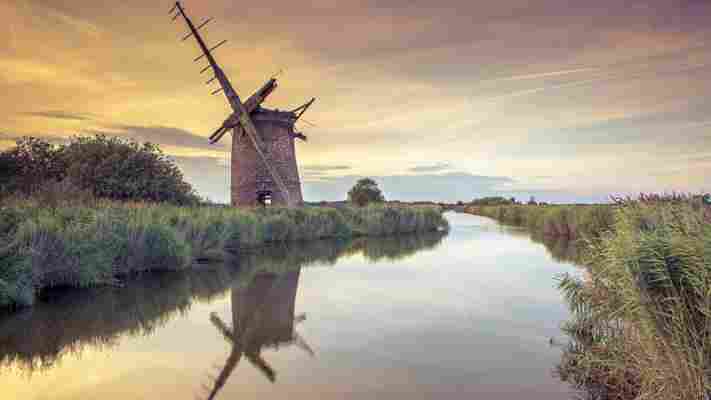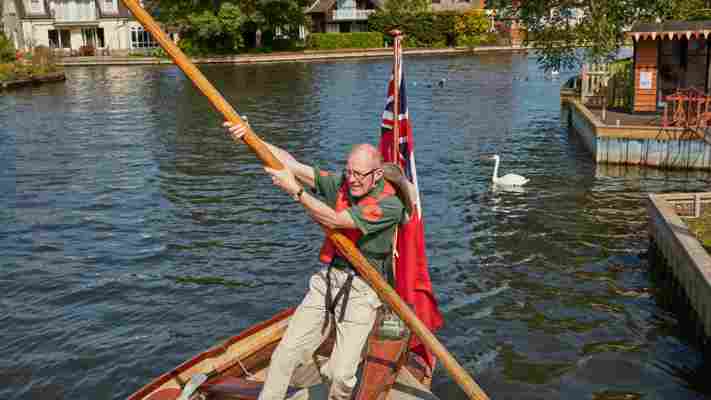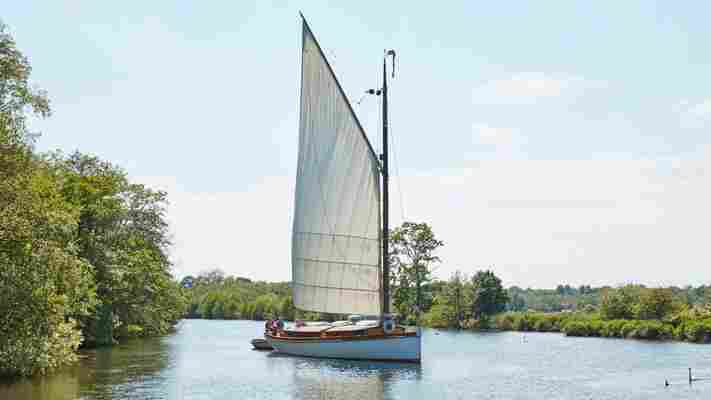We were so close I could have touched it. The boat's enormous white sail, outstretched like the wing of a swan poised for battle, was pulled tight with an unexpected gust of wind and we were headed straight for a speedboat anchored on the riverbank.

"Quant!" shouted Dean Howard, our skipper, from the helm.
The crew sprang into action, running across the deck to haul a wooden stick the length of the boat into the water. Using their bodies as leverage, they pushed the quant into the muddy riverbed below in an attempt to turn 15 tonnes of solid wood in a few seconds. We held our breath: nothing. But a boat this size requires patience. With the grace of a ballet dancer, our 52ft wherry turned at the last possible moment, missing the stationary speedboat by an arm's length.
I was sailing the Norfolk Broads, a wetland in the east of England with more navigable waterways than Venice or Amsterdam, aboard White Moth, a wide, solid oak wherry unique to the Norfolk Broads. With more than 125 miles of lock-free rivers and lakes stretching across the counties of Norfolk and Suffolk, the Broads are a network so large that, up until the 1950s, they were thought to be a natural phenomenon. It was only when British botanist Joyce Lambert discovered that most of the lakes had perpendicular walls and a flat bottom that the Broads' history was rewritten. Further research by the University of Cambridge found that Britain's largest protected wetland had in fact been hand-dug by medieval peat diggers between the 12th and 14th Centuries.
Over the centuries that followed, flooded peat diggings became a vital trading network for what was then one of Britain's most prosperous counties (King's Lynn, an hour north of the Broads, was a major Hanseatic League port between the 13th and 15th Centuries, bringing many wealthy merchants to its shores). In the 17th Century, especially designed boats known as wherries were built to transport reeds, timber and, during England's Civil War, soldiers and ammunition up and down the Broads – and, if conditions were right, to and from ships anchored along the Norfolk coast. Capable of carrying up to 40 tonnes and perfectly designed for the Broads' shallow, sheltered waters, wherries remained the primary form of transportation in Norfolk and Suffolk for two centuries.

A quant is used to propel or turn a boat in the shallow waters of the Norfolk Broads (Credit: Wherry Yacht Charter)
The introduction of more efficient modes of transport like the railway and steam-powered road lorries in the late 19th Century, however, marked the end for Norfolk's trading wherries. As trade opportunities decreased, forward-thinking wherrymen converted their boats during the summer, adding windows below deck and dividing the hold into cabins for the influx of Victorian holidaymakers arriving from London by steam train. The spacious boats were so popular that by World War Two, around 100 specially built wherry yachts, fitted with luxurious cabins and pianos for entertainment (White Moth still has hers), had replaced all trading wherries on the Broads.
You may also be interested in: • The least British of the British Isles? • England's sleepy Scientology town • The UK's real-life Treasure Island
But even pleasure wherries couldn't stand the test of time. As holidays abroad became more popular in the 1960s and '70s, and expensive-to-maintain skippered wherries were replaced with hire-your-own speedboats, many were destroyed or left to deteriorate. Today, only eight sailable Norfolk wherries exist – five of which, including White Moth, are owned by Wherry Yacht Charter , a not-for-profit organisation that runs chartered sailings aboard the wherries to fund their conservation.
Out of danger and a calm, open river ahead, White Moth sailed us slowly down the River Bure as we stretched out on deck. Away from day-trippers churning the river in rented speedboats, I closed my eyes and strained to hear the Broads' music: the rustle of a fabric sail caught in a headwind; the gentle lapping of water against wood; the faint air swish of a bird, perhaps a reed warbler or copper-throated swallow, flitting between mist-shrouded trees, the grey-blue water rising and falling at their bottle-green leaves like liquid silver.
"These boats are living history, but they're also a way to get closer to nature," said Bill Housden, who volunteered as a tea boy for Wherry Yacht Charter 20 years ago and is now the treasurer and one of the skippers. "Wherries are so quiet and slow-moving that birds perch on the side and otters swim metres away from us. It's difficult to explain, but that feeling of being seamlessly part of nature is incredibly special."
There will be a time when we'll have to rethink the way we live in the UK. When that happens, we'll need the knowledge of people who lived more sustainably than us.
When I ask why it's important for wherries to be on the water rather than in a museum, despite the cost of keeping them operational, he responded: "There will be a time when we'll have to rethink the way we live in the UK. When that happens, we'll need the knowledge of people who lived more sustainably than us. Some say we're stuck in the past, but I think we're looking to the future – a greener, more sustainable future where we work with nature, not against it."

Wherries are unique to the Norfolk Broads – and White Moth is among the last sailable vessels (Credit: Wherry Yacht Charter)
Equally as passionate about the Broad's role in creating a more eco-conscious culture in Britain is Nicola Hems, curator of The Museum of the Broads since 2011. "Compared to other national parks in the UK, the Broads are underappreciated," Hems said, as she showed me the museum's wherry replicas and Norfolk Broads holiday posters from the 1950s. "It's such a unique and fragile ecosystem with a rich history, yet we're not doing enough to protect it."
The Broads isn't just about nature and science – it's about people
Despite being home to more than a quarter of Britain's rarest animals and aquatic plants, including the swallowtail butterfly and holly-leaved naiad, decades of untreated sewage and fertilisers have polluted the water and endangered its endemic species. Flooding and rising sea levels are also a concern. Although the Norfolk Wildlife Trust has begun bio-manipulation and rewilding projects to tackle the effects of pollution and climate change, Hems believes that getting the public to fall in love with the Broads is key to its survival.
"The Broads isn't just about nature and science – it's about people. They were made by ordinary people, and they'll need to be protected by ordinary people, too. I hope that by bringing the Broads to life in this museum, more people will appreciate how special Norfolk's waterways are and want to protect them."
When I asked what role she thinks wherries play in the survival of the Broads, Hems responded: "The museum can teach you its history, but getting out onto the water is what makes you fall in love with the Broads."
While wherries have only made their comeback as pleasure boats, an hour north of the Broads, Coastal Exploration Company , which offers sailing trips along the north Norfolk coast aboard 1950s wooden crab boats, is taking things one step further. Inspired by King's Lynn Hanseatic League history – a guild of merchants that traded wool, cloth and salt in the North and Baltic seas between the 13th and 15th Centuries – the adventure company recently delivered cargo under sail between Wells-next-the-sea and King's Lynn for the first time in 600 years.
Wherries were the primary form of transportation in Norfolk and Suffolk for two centuries (Credit: The Museum of the Broads)
"The way we deliver goods in the UK has to change," said Henry Chamberlain, Coastal Exploration founder and Royal Marine, as we set sail into the lavender-purple salt marshes of north Norfolk. "Our roads are full; our waters polluted. We need to find a way to do better.
Coastal Exploration Company has so far only delivered Wells-based Barsham Brewery's craft ale to King's Lynn but hopes that this major milestone will encourage more local businesses to jump on board. "There's lots of talk about sustainably sourced food in our country," said Chamberlain. "But what about sustainably delivered food? It's the missing link in our sustainability chain."
Despite the challenges, Wherry Yacht Trust and Coastal Exploration Company believe that promoting carbon-free transportation, whether that be for pleasure or trade, is key to ensuring one of Britain's last great wildernesses is here for future generations. As we sailed into a churning grey sea, my hair matted with sea salt and my face splattered with rain, I finally understood something Chamberlain had said to me earlier: "It's only when we experience nature in all its raw, unpredictable beauty that we'll truly want to save it."
--
Join more than three million BBC Travel fans by liking us on Facebook , or follow us on Twitter and Instagram .
If you liked this story, sign up for the weekly bbc.com features newsletter called "The Essential List". A handpicked selection of stories from BBC Future, Culture, Worklife and Travel, delivered to your inbox every Friday.
Leave a Comment